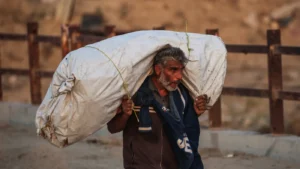Gaza’s Palestinians sceptical after UN resolution ‘ignored humanitarian needs’

A Palestinian man carries his belongings along a bridge in Nuseirat, Gaza Strip, on 11 November 2025
Maha Hussaini reports in Middle East Eye on 19 November 2025:
Palestinians in the Gaza Strip have reacted with scepticism to the UN resolution authorising foreign governance and forces in the war-torn territory.
After more than two years of Israeli genocide, most of Gaza’s 2.3 million people are internally displaced and lack access to basic necessities such as food, shelter, electricity and medical services. Many had hoped the UN would help alleviate the devastating humanitarian crisis in the enclave.
However, the passing of the US-drafted UN Security Council resolution on Monday showed that the humanitarian needs of the population are still not the top priority, said resident Abu Malek Jerjawi. “The Security Council should have prioritised reconstruction and the urgent expansion of humanitarian relief,” Jerjawi told Middle East Eye.
“More than one million people need shelter, and even the most basic supplies are still being blocked by Israel,” he added.
Even worse, he said, the “deeply disappointing” resolution now “makes improving the humanitarian situation conditional on political requirements”. He continued: “The Council disregarded all humanitarian needs and tied them to political considerations by linking reconstruction to disarmament. Legitimising this connection between humanitarian needs and political conditions is a disaster.”
Adopted on Monday, the UNSC 2803 resolution backs a Donald Trump-led transnational governing body of Gaza, as well as the creation of an international force to ensure the “process of demilitarising the Gaza Strip” and the “permanent decommissioning of weapons from non-state armed groups”. According to the resolution, it will be authorised to “use all necessary measures to carry out its mandate”.
The apparent linkage has raised concerns among some that humanitarian needs are being subordinated to political conditions, and that the recovery of more than two million civilians will depend on steps unlikely to be achievable in the short term.
Satellite analysis by the United Nations Satellite Centre (UNOSAT) shows that, as of October, roughly 81 percent of all structures in the Gaza Strip had been destroyed or damaged over more than two years of conflict. UNOSAT recorded 123,464 destroyed buildings, 17,116 severely damaged, 33,857 moderately damaged and 23,836 possibly damaged – a total of 198,273 affected structures.
As a result, most of Gaza’s population is now living in temporary shelters, including makeshift tents, schools and badly damaged homes.
‘Our voices don’t matter’
Nermin Basel, a Gaza resident who fled during the first year of the war, said she can only trust any international plan if it guarantees that displaced Palestinians will be able to return.
